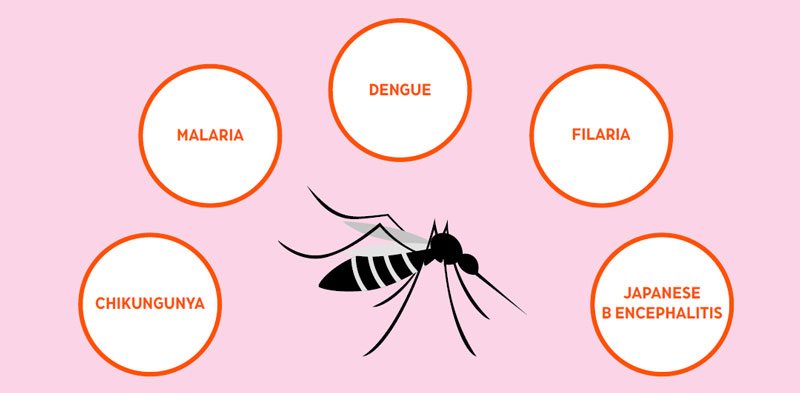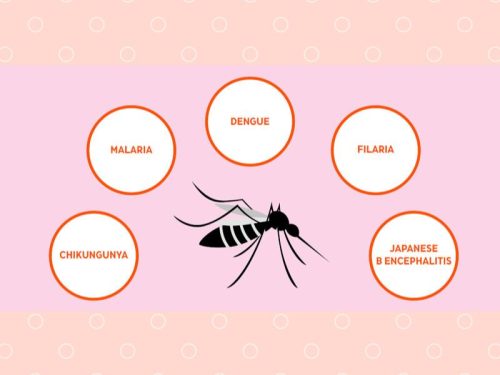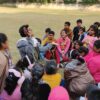Fighting mosquito-borne diseases
A good monsoon replenishes ground water supply and ensures a good harvest. But it also leaves behind pools of stagnant water which are ideal breeding grounds for mosquitoes. Here’s some information on the most common mosquito-borne diseases and how to prevent and/or alleviate them.

In India, the onset of the monsoon season is the best and worst of times. Plentiful rains replenish ground water supply and ensure a good harvest. But they also leave behind pools of stagnant water which are ideal breeding grounds for mosquitoes. The most common mosquito-borne diseases to strike during the monsoon season are dengue, malaria and chikungunya which are caused by Aedes Egypti, Anopheles and Culex mosquitoes. Here’s some useful information on the most common mosquito-borne diseases and how to prevent and/or alleviate them.
Malaria
Anopheles and Culex mosquitoes swarm out in the dark and attack ferociously from dawn to dusk. They are a dull grey colour and the female requires a blood meal to lay eggs. Malaria is transmitted by female anopheles mosquitoes. Most people residing in the tropics have developed innate immunity to malaria. Typically, malaria strikes in non-immune individuals. After a variable incubation period, it manifests as a fever, headache, aches and pains and diarrhoea. Most people believe that the most recognisable symptom of malaria is high fever with shivering and sweating. This pattern takes longer to establish itself. The disease may also creep in insidiously without high fever, eventually causing anaemia, fatigue and lethargy. Malaria is particularly severe and dangerous in children, pregnant women and in people who do not have a spleen.
Diagnosis
Diagnosis of malaria is based on the examination of blood smears. Once confirmed, a complete course of medication is required because the parasite can remain dormant in the liver, to re-emerge after a variable period causing a relapse or chronic infection.
The Culex mosquito spreads filaria. Symptoms are fever or swelling of the lower limbs, scrotum and breasts. Diagnosis is through a blood smear. Sometimes filaria can manifest as tropical pulmonary eosinophilia, with coughing and wheezing. It is diagnosed with elevated levels of eosinophils in the blood count.
The culex mosquito also transmits Japanese B encephalitis, a virus infection. It starts with a fever and can cause swelling of the brain, coma, convulsions and death.
Dengue
The Aedes Egypti mosquito, which causes dengue and chikungunya, on the other hand, has an attractive physical appearance. It has a striped body like that of a tiger. Unfortunately, it is domesticated and rarely strays from its place of birth. It loves humans and their environment. Unlike the dawn and dusk attacks of other mosquitoes, it bites in the daytime also. It hides in home upholstery and furniture and attacks a person repeatedly or bites several human beings in the vicinity. This is why several members of a family can develop dengue together.
In dengue, fever develops abruptly, four to 10 days after a bite. There may be a red rash, headache, pain behind the eyes, in the joints and abdomen. Other symptoms are nausea, vomiting and throat pain. At this stage, it is difficult to distinguish dengue from other viral fevers.
Dengue-infected patients begin to develop antibodies to the virus which are detectable in 50 percent of cases after three-five days of the onset of illness, and in 99 percent by day ten. At this time, the dengue test is positive. Within a few days, the white blood cells and platelet counts drop. This can produce bleeding, affect the liver and cause enzymes to increase production. The blood vessels become permeable and fluid leaks out causing collapse and shock as the liver, heart and kidneys are inadequately perfused.
A person usually recovers spontaneously from the first dengue attack. It cannot be cured with antibiotics. Treatment is mainly supportive, to reduce the temperature (paracetamol 10-15mg/kg per dose every four-six hours in children and 500 mg in adults). Aspirin, nonsteroidal anti-inflammatory drugs (NSAIDs), and corticosteroids should be avoided.
Chikungunya
One of the mosquito-borne diseases, Chikungunya manifests suddenly with fever and intense pain in the joints of the hands and feet. Once the fever subsides, the joint pain remains for around 10-15 days in the young, one-two months in the middle-aged and three-six months or even five years in the elderly. Antibiotics don’t cure this viral infection and treatment is mainly supportive.
Treatment
• Malaria is treated with anti-malarial drugs.
• Filaria and tropical pulmonary eosinophilia can be treated with a combination of albendazole, ivermectin and diethylcarbamazine citrate (DEC).
• Treatment in dengue, chikungyunya and Japanese B encephalitis is only supportive.
Prevention
• Immunization is available to prevent Japanese B encephalitis.
• Preventing mosquito bites is the best antidote. Cut a lemon and stick six cloves in it. Mosquitoes detest the smell of cloves and citrus.
• Drain stagnant water. Inspect your immediate environment for garbage such as old tyres, bottle caps, and tree leaves. Turn over bottles caps and coconut shells to ensure rainwater does not accumulate and stagnate. Straighten sagging canvas and plastic coverings periodically. As little as 2 ml of water is enough for mosquitoes to lay eggs.
• Empty air-conditioning and cooler trays. Alternatively, put a handful of salt into the tray so that mosquitoes cannot breed.
• Don’t place trays under potted plants. Empty pots and vases regularly.
• Fix mosquito mesh on open tanks and wells.
• Windows and doors can be mosquito proofed using inexpensive plastic mesh.
• Stock tanks and ponds with small, larva-eating fish such as guppies (Gambusia, Lebister).
• Pouring a little kerosene or oil on stagnant water creates a thin film on the surface that prevents larvae from breathing.
• Insecticide sprays, mats and coils drive away mosquitoes. Unfortunately, they are also toxic to humans. Avoid using them.
• Use electronic mosquito repellent machines and lights.
• Application of mosquito repellents on clothing (not skin) is effective only for a few hours. Patches (mosquito tattoos) that contain pure citronella extract can be placed on clothing. Equal volumes of vanilla extract and water (homemade) applied on the skin repels mosquitoes for an hour.
• BTI (bacillus thuringiensis israelensis) is a naturally occurring bacterium that kills immature mosquito larvae. It is available with the government malaria control division. It is non-toxic to humans
(Dr. Gita Mathai is a well-known Vellore-based pediatrician and author of Staying Healthy in Modern India)

















Add comment